3/16/2023 | Volume 26 issue 2
This newsletter and the advice herein are free. You usually get what you pay for.
Crop weather
Rainfall, air and soil temperatures, degree-days, soil moistures, and other current and historical weather data for the University of Minnesota Southwest Research and Outreach Center (SWROC), a little spot about two miles west of Lamberton, MN, can be found at https://swroc.cfans.umn.edu.
Winter 2022-23 continues to hang tough. Relatively shallow frost depths (27” under bare ground) continue at the SWROC. I am hoping this will allow snow melt to be absorbed for a needed soil moisture recharge here.
Many of our insect pests cannot survive the winters here (e.g., armyworm, black cutworm, cereal aphids). It’s not just retirees that have evolved strategies to persist through tough Minnesota winters.
Several factors determine whether economic problems from these migratory insects will occur in 2023. How well insects wintered in states to our south determines the potential starting populations. Migrating insects take advantage of weather systems to move north in the spring. Insects ready to migrate north need appropriate weather systems to bring them north. The larger the migrating insect populations, and the more frequent southerly winds, the greater the risk to Minnesota crops. Insects migrating long distances often travel on low-level jet streams and drop out with rain. Finally, once they arrive, the migrating pests need suitable hosts and weather to develop into a yield-threatening population.
In this issue, I throw out some thoughts on several insect pests of small grains and alfalfa for 2023.
Thoughts on a few small grain (wheat, rye, oats barley) insect pests
True Armyworms (TAW)
- This is a different species than the fall armyworm that plagues southern states and showed up in Minnesota in large numbers in the fall of 2021.
- TAW larvae feed on grasses including grass grain and forage crops.
- Our Midwest TAW populations spend the winter to the south where several stages winter in grasses and grass crops.
- We have armyworm migrations into MN every spring.
- That January bout with cold and ice that dipped well into
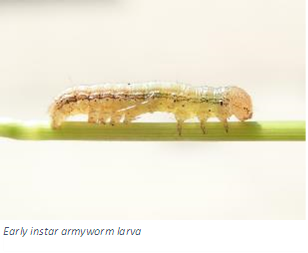
- Texas, combined with drought-stressed southern plains grasses may have thinned the armyworm herd somewhat. However, armyworms winter across a wide area, south of the soil freeze line.
- The first migrant moths can show up as early as late April and May. Blacklight traps, and to some extent, pheromone traps can provide insight into their size and timing and help make scouting more efficient. Watch for alerts.
- TAW moths look for dense, lush grasses to lay their eggs. These areas can be pastures, grassy weeds, grasses on field borders, and cereal grains including cereal rye cover crops. Focus your initial scouting on these areas.
- Early feeding is usually low on the plant and larvae avoid light. A sweep net can help you detect small TAW larvae but economic thresholds are based on the number of larvae/ ft2. Dislodge larvae by shaking plants onto the soil surface, taking care to look under debris.
- As they deplete food, larvae will move to find new live grasses, sometimes in large numbers. Once infested fields are found, pay close attention to other nearby fields. infested fields.
- Most feeding is done during the last two larval stages. Find infestations early. Waiting to find infested fields by asking what the crop duster is spraying can be expensive.
- Cool, wet weather or frequent early-season thunderstorms in 2023 will indicate increased 2023 armyworm risk. The former encourages the lush grass growth that attracts egg-laying moths, and the plant lodging that congregates larvae. Thunderstorms are associated with low-level jet streams that help bring migrating moths north.
Aphids
- There are three species of cereal aphids (Bird cherry-oat, English grain, and greenbug) that are pests of Minnesota wheat, oats, barley, and rye. Corn leaf aphids are also occasionally found. Bird cherry-oat (BCOA) and English grain aphids (EGA) are the most common, and in spring are the first to show up in SW Minnesota small grains. Cereal aphids will move to corn as small grains mature.
- With the possible exception of a few BCOA in a very warm winter, cereal aphids cannot winter here.
- Winter cereals, including cover crops are often colonized by migrating aphids first and provide an environment for early-season aphid populations to build. They are a good place to get a feel for how infestations are developing.
- Northern MN cereal crops often get a heads-up when
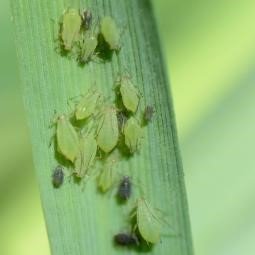
- migrating aphids first appear to the south.
- Scouting is important as the sap-feeding aphids can impact yield.
- Barley yellow dwarf virus can be transmitted to cereal crops by aphid feeding. Symptoms and yield loss can be severe when seedlings are infected.
- Infected winter cereals can harbor the virus here.
- It is important to find potential economic infestations early. On young plants, BCOAs are usually found low on the plant, sometimes in the leaf sheath. English grain aphids tend to occur higher on the plant.
- Until scouting tells us when aphids arrive, and how populations develop, it is difficult to predict any 2023 problems from cereal aphids.
Wheat stem sawfly
- This wasp-like hymenopteran is a native, originally reported
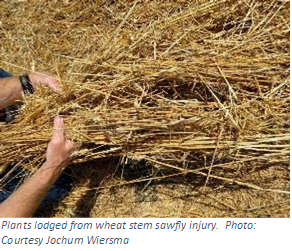
- on native prairie grasses, and has adapted to wheat and barley.
- Its range as a wheat pest has expanded into Minnesota from western wheat-growing areas. Some yield-limiting populations have occurred in NW Minnesota.
- The pale to cream-colored, larvae feed inside the stem and reduce grain yield. As wheat matures, and the larvae prepare to diapause they move to the base of the stem where they chew a groove around the inside of the stem.
- Stems lodge as stems break off with the wind and reduce harvest ability. Close to harvest, look for areas of lodged plants whose stems look like they have been cut off. Swath heavily infested fields at higher grain moisture levels.
- Pre-pupae larvae overwinter in wheat stubble. Tillage may reduce overwintering success.
- Natural enemies are known and help keep wheat stem sawflies in check.
- I don’t expect wheat stem sawfly issues in southern Minnesota. If you grow or scout wheat watch for wheat stem maggot injury anyhow.
Hessian fly
- Is an introduced fly in the gall midge family (a distant cousin
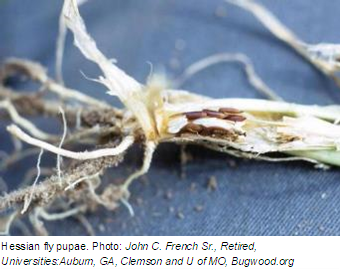
- to soybean gall midge) that infests wheat and to a lesser extent rye and barley?
- The pest overwinters as a pupa in wheat stubble. Adults emerge in the spring when the adults look for nearby young wheat plant leaves to lay eggs. Larvae infest stems and feed on sap. Infestations can stunt plants and thin stands. In June, the flies pupate at the base of the plant. Adults emerge beginning in August and lay eggs on winter wheat (rye is a lesser host) and volunteer wheat. The pupae of this generation overwinter.
- Stunted plants and thin stands are a clue to a possible Hessian fly infestation. Look for the pupae (they look like flax seeds in size and color - see photo) in lower stems.
- The Hessian fly risk increases in fields in areas where volunteer wheat is allowed to persist through fall or where early planted winter wheat/winter rye is planted early (before late September in southern MN and mid-September in northern MN). These plants can provide a “green bridge” that allows the pupa to persist through the winter.
- Newer wheat varieties lack host plant resistance that was present in many older varieties.
- With very limited small grain acres in southern MN, Hessian flies are rare. This may change as cereal rye cover crop acreages increase. I hope and expect that any Hessian fly infestations in southern Minnesota to will be a curiosity rather than a yield threat.
Alfalfa
An enjoyable crop for entomologists, alfalfa is typically a zoological garden with many insect species in abundance. Many are beneficial predators and parasitic wasps, and a few have to potential to threaten yield. To avoid impacts on natural enemies, it is wise to leave any sub-economic populations alone.
Alfalfa insect management means a heavy-duty, 15-inch diameter sweep net. If you don’t have one buy one from several sources including, but not limited to Sweep Nets Company, Gemplers, Great Lakes IPM, and Forestry Suppliers. Sweep nets are useful when sampling insects in many other crops. (Sweep net Tips: Sweep nets see hard use. Invest in a good net with replaceable bags. Make sure the handle is long enough for comfortable use. Aluminum handles are perhaps more durable, but they will without wrapping will leave aluminum residue on your hands.
Alfalfa Weevil (AW)
- Alfalfa weevil has become a difficult 3insect pest in some
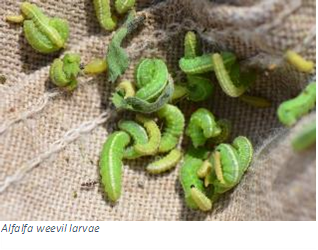
- areas including parts of Central and West Central Minnesota.
- Once relatively easy to manage with scouting, by adjusted cutting times and properly timed insecticides, some AW populations may have found a new playbook. Why the harder-to-manage AW Populations? Several factors could be involved including very high weevil populations, mistimed management, insecticide resistance, loss of biocontrol, or egg laying prolonged by weather or genetics. New research is needed to replace guesses, educated or otherwise.
- It is important to start scouting alfalfa well before 1st cutting, especially in areas where AW has been abundant in the past.
- Alfalfa weevils overwinter as adults (possibly some eggs for one AW strain) and given the 2022-23 winter, they should have overwintered in good shape in sheltered areas in or near alfalfa fields. There could be two biological strains of alfalfa weevils in MN. The eastern and western strains differ in when the adults are active in alfalfa, if any of the eggs are laid in alfalfa stems during the fall, the timing of peak larval populations, and susceptibility to parasites. Some alfalfa fields may have more than one AW strain. The survival of fall-laid eggs or delayed movement of adults back into alfalfa in the spring can prolong infestation well into, and sometimes past, second cutting.
- Pyrethroid insecticide resistance has been found in AW populations in some western states and there is a possibility that it may exist in some Minnesota populations also. If you did spray, check your work. Did the insecticide application do what you thought it would?
- Managing without chlorpyrifos is possible. Some folks are hard to convince but you don’t need to kill every insect in the field – you really don’t. Choose insecticides that are effective on the insect that is threatening yield in the alfalfa field. If you need to treat a field more than once, use a different insecticide group.
- Early detection of potential problems Plan ahead- regardless of any potential insecticide resistance, the timing of insecticides and cutting is important.
- The grower’s alfalfa production system plans should influence cutting and insecticide decisions.
- Alfalfa weevil populations are likely to remain the same or increase in 2023. Scout early and often.
Pea aphids
- The pea aphid is the most common aphid species found in alfalfa. It overwinters in Minnesota. Spotted alfalfa, cowpea, and blue alfalfa aphids are also sometimes present in MN alfalfa.
- Alfalfa-infesting aphids, other than spotted alfalfa aphids, need moderate temperatures to thrive.
- Aphids have high reproductive potential. Given, good environmental conditions populations can increase rapidly, especially if a pesticide application removes natural enemies.
- Watch insecticide-treated fields. Poorly controlled aphid
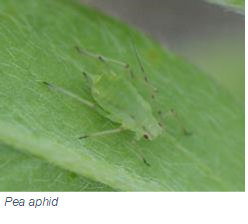
- populations indicate application issues or possibly insecticide resistance. Some reports have hinted at potential pyrethroid resistance pea aphids.
- Aphids are often abundant and can cause concern at populations well below yield-threatening levels Don’t panic, alfalfa can tolerate high aphid populations (up to 100/stem), particularly with good soil moisture. Some literature indicates a higher threshold for spotted alfalfa aphids.
- Scouting is important to help you make good pesticide decisions. Focus on the pest that is threatening yield and alfalfa stage. Sefina®, for example, is quite specific to aphids with minimal impact on beneficial insects and non-aphid pests.
- Don’t treat aphids with an insecticide group that has already been used in the field that growing season.
- A cool spring will increase the pea aphid risk. Fields that received a broad-spectrum insecticide applied are at higher risk.
Potato leafhopper
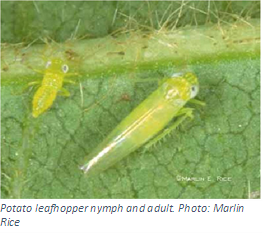
- Bright green potato leaf hoppers (PLH) migrants typically arrive in MN alfalfa late in the first cutting or during the second cutting.
- Recognize the difference between PLH and the gray-olive aster leafhopper adults that sometimes inhabit alfalfa grass mixes. Both species have a wide host range, but only the PLH are alfalfa pests.
- PLH adults are very mobile and will move between hostplants and fields. For example, adults will move from cut alfalfa to nearby soybeans and then back to alfalfa as regrowth develops.
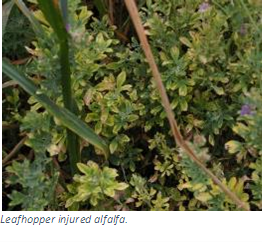
- Pay close attention to new seeding alfalfa. PLH will find small alfalfa plants under a nurse crop canopy.
- PLH-resistant varieties reduce risk and thresholds are higher for the resistant varieties. However, they still need scouting and may need an insecticide treatment when PLH populations are very high.
- If you are seeing PLH injury symptoms (discolored yellow to reddish wedges on leaflet tips, stunted plants in severe cases), your alfalfa has already suffered yield and quality issues.
- It’s too early for me to make a potato leafhopper guess. The timing and intensity of migration will help determine PLH risk.
Grasshoppers and blister beetles
During late summer and fall, red-legged grasshoppers find alfalfa fields a good place to lay their eggs. Aside from any potential yield impacts from grasshopper feeding, they can trigger another pest issue. The larvae of several species of blister beetles feed on grasshopper eggs - a good thing unless you’re a grasshopper egg. Unfortunately, blister beetle adults contain a chemical compound that is toxic to horses – a bad thing if you’re a horse that eats hay with blister beetles in it. Blooming alfalfa can congregate adult blister beetles emerging within the field or nearby.
Over the past two years, grasshopper populations have increased in some areas of MN, including SW MN. Grasshopper females laid eggs last fall. Blister beetle females did too. Blister beetles should be on everyone’s radar when scouting alfalfa this summer. For more information see blister beetles in alfalfa hay.
Happy trails,
Bruce
